Qin Liu
MetaScale: Test-Time Scaling with Evolving Meta-Thoughts
Mar 17, 2025Abstract:One critical challenge for large language models (LLMs) for making complex reasoning is their reliance on matching reasoning patterns from training data, instead of proactively selecting the most appropriate cognitive strategy to solve a given task. Existing approaches impose fixed cognitive structures that enhance performance in specific tasks but lack adaptability across diverse scenarios. To address this limitation, we introduce METASCALE, a test-time scaling framework based on meta-thoughts -- adaptive thinking strategies tailored to each task. METASCALE initializes a pool of candidate meta-thoughts, then iteratively selects and evaluates them using a multi-armed bandit algorithm with upper confidence bound selection, guided by a reward model. To further enhance adaptability, a genetic algorithm evolves high-reward meta-thoughts, refining and extending the strategy pool over time. By dynamically proposing and optimizing meta-thoughts at inference time, METASCALE improves both accuracy and generalization across a wide range of tasks. Experimental results demonstrate that MetaScale consistently outperforms standard inference approaches, achieving an 11% performance gain in win rate on Arena-Hard for GPT-4o, surpassing o1-mini by 0.9% under style control. Notably, METASCALE scales more effectively with increasing sampling budgets and produces more structured, expert-level responses.
Referring to Any Person
Mar 11, 2025Abstract:Humans are undoubtedly the most important participants in computer vision, and the ability to detect any individual given a natural language description, a task we define as referring to any person, holds substantial practical value. However, we find that existing models generally fail to achieve real-world usability, and current benchmarks are limited by their focus on one-to-one referring, that hinder progress in this area. In this work, we revisit this task from three critical perspectives: task definition, dataset design, and model architecture. We first identify five aspects of referable entities and three distinctive characteristics of this task. Next, we introduce HumanRef, a novel dataset designed to tackle these challenges and better reflect real-world applications. From a model design perspective, we integrate a multimodal large language model with an object detection framework, constructing a robust referring model named RexSeek. Experimental results reveal that state-of-the-art models, which perform well on commonly used benchmarks like RefCOCO/+/g, struggle with HumanRef due to their inability to detect multiple individuals. In contrast, RexSeek not only excels in human referring but also generalizes effectively to common object referring, making it broadly applicable across various perception tasks. Code is available at https://github.com/IDEA-Research/RexSeek
A Survey on Mechanistic Interpretability for Multi-Modal Foundation Models
Feb 22, 2025



Abstract:The rise of foundation models has transformed machine learning research, prompting efforts to uncover their inner workings and develop more efficient and reliable applications for better control. While significant progress has been made in interpreting Large Language Models (LLMs), multimodal foundation models (MMFMs) - such as contrastive vision-language models, generative vision-language models, and text-to-image models - pose unique interpretability challenges beyond unimodal frameworks. Despite initial studies, a substantial gap remains between the interpretability of LLMs and MMFMs. This survey explores two key aspects: (1) the adaptation of LLM interpretability methods to multimodal models and (2) understanding the mechanistic differences between unimodal language models and crossmodal systems. By systematically reviewing current MMFM analysis techniques, we propose a structured taxonomy of interpretability methods, compare insights across unimodal and multimodal architectures, and highlight critical research gaps.
Unsupervised dense retrieval with conterfactual contrastive learning
Dec 30, 2024Abstract:Efficiently retrieving a concise set of candidates from a large document corpus remains a pivotal challenge in Information Retrieval (IR). Neural retrieval models, particularly dense retrieval models built with transformers and pretrained language models, have been popular due to their superior performance. However, criticisms have also been raised on their lack of explainability and vulnerability to adversarial attacks. In response to these challenges, we propose to improve the robustness of dense retrieval models by enhancing their sensitivity of fine-graned relevance signals. A model achieving sensitivity in this context should exhibit high variances when documents' key passages determining their relevance to queries have been modified, while maintaining low variances for other changes in irrelevant passages. This sensitivity allows a dense retrieval model to produce robust results with respect to attacks that try to promote documents without actually increasing their relevance. It also makes it possible to analyze which part of a document is actually relevant to a query, and thus improve the explainability of the retrieval model. Motivated by causality and counterfactual analysis, we propose a series of counterfactual regularization methods based on game theory and unsupervised learning with counterfactual passages. Experiments show that, our method can extract key passages without reliance on the passage-level relevance annotations. Moreover, the regularized dense retrieval models exhibit heightened robustness against adversarial attacks, surpassing the state-of-the-art anti-attack methods.
MetaScientist: A Human-AI Synergistic Framework for Automated Mechanical Metamaterial Design
Dec 20, 2024



Abstract:The discovery of novel mechanical metamaterials, whose properties are dominated by their engineered structures rather than chemical composition, is a knowledge-intensive and resource-demanding process. To accelerate the design of novel metamaterials, we present MetaScientist, a human-in-the-loop system that integrates advanced AI capabilities with expert oversight with two primary phases: (1) hypothesis generation, where the system performs complex reasoning to generate novel and scientifically sound hypotheses, supported with domain-specific foundation models and inductive biases retrieved from existing literature; (2) 3D structure synthesis, where a 3D structure is synthesized with a novel 3D diffusion model based on the textual hypothesis and refined it with a LLM-based refinement model to achieve better structure properties. At each phase, domain experts iteratively validate the system outputs, and provide feedback and supplementary materials to ensure the alignment of the outputs with scientific principles and human preferences. Through extensive evaluation from human scientists, MetaScientist is able to deliver novel and valid mechanical metamaterial designs that have the potential to be highly impactful in the metamaterial field.
LiVOS: Light Video Object Segmentation with Gated Linear Matching
Nov 05, 2024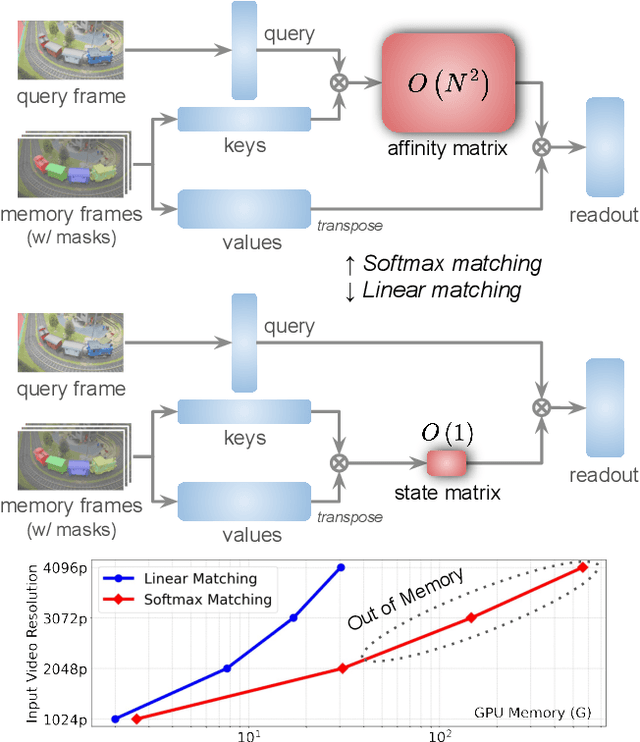
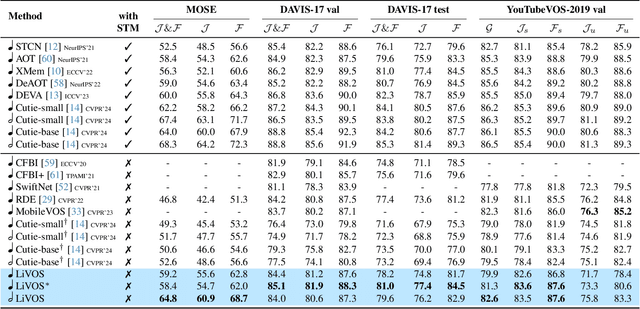
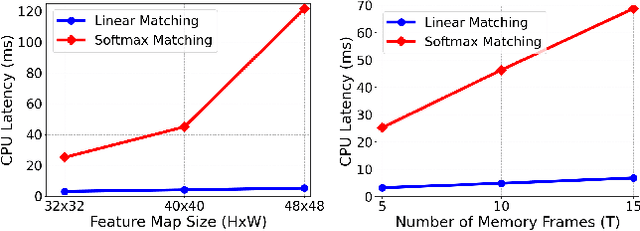
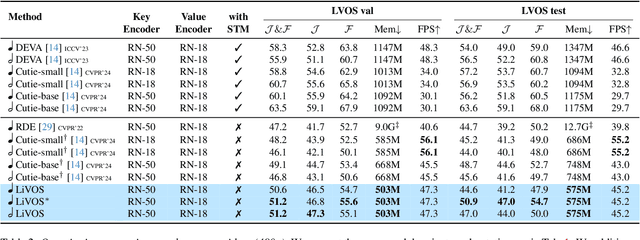
Abstract:Semi-supervised video object segmentation (VOS) has been largely driven by space-time memory (STM) networks, which store past frame features in a spatiotemporal memory to segment the current frame via softmax attention. However, STM networks face memory limitations due to the quadratic complexity of softmax matching, restricting their applicability as video length and resolution increase. To address this, we propose LiVOS, a lightweight memory network that employs linear matching via linear attention, reformulating memory matching into a recurrent process that reduces the quadratic attention matrix to a constant-size, spatiotemporal-agnostic 2D state. To enhance selectivity, we introduce gated linear matching, where a data-dependent gate matrix is multiplied with the state matrix to control what information to retain or discard. Experiments on diverse benchmarks demonstrated the effectiveness of our method. It achieved 64.8 J&F on MOSE and 85.1 J&F on DAVIS, surpassing all non-STM methods and narrowing the gap with STM-based approaches. For longer and higher-resolution videos, it matched STM-based methods with 53% less GPU memory and supports 4096p inference on a 32G consumer-grade GPU--a previously cost-prohibitive capability--opening the door for long and high-resolution video foundation models.
SudoLM: Learning Access Control of Parametric Knowledge with Authorization Alignment
Oct 18, 2024Abstract:Existing preference alignment is a one-size-fits-all alignment mechanism, where the part of the large language model (LLM) parametric knowledge with non-preferred features is uniformly blocked to all the users. However, this part of knowledge can be useful to advanced users whose expertise qualifies them to handle these information. The one-size-fits-all alignment mechanism undermines LLM's utility for these qualified users. To address this problem, we propose SudoLM, a framework that lets LLMs learn access control over specific parametric knowledge for users with different credentials via authorization alignment. SudoLM allows authorized users to unlock their access to all the parametric knowledge with an assigned SUDO key while blocking access to non-qualified users. Experiments on two application scenarios demonstrate that SudoLM effectively controls the user's access to the parametric knowledge and maintains its general utility.
Order-aware Interactive Segmentation
Oct 17, 2024
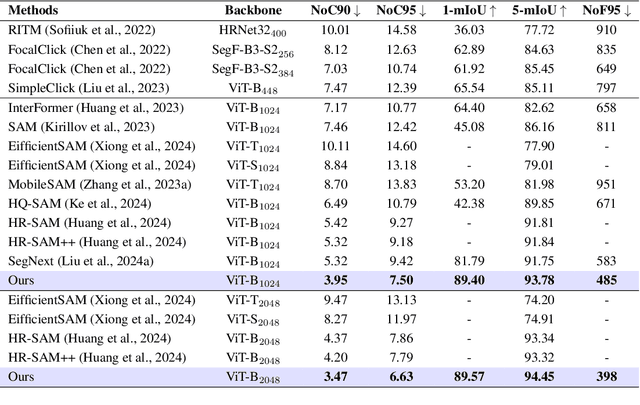
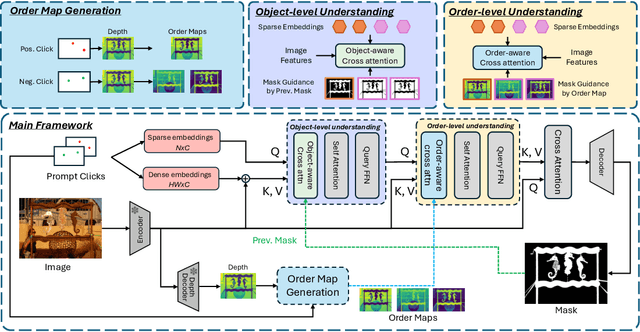
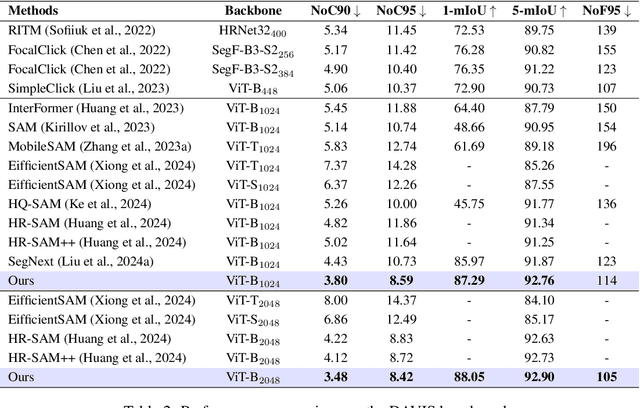
Abstract:Interactive segmentation aims to accurately segment target objects with minimal user interactions. However, current methods often fail to accurately separate target objects from the background, due to a limited understanding of order, the relative depth between objects in a scene. To address this issue, we propose OIS: order-aware interactive segmentation, where we explicitly encode the relative depth between objects into order maps. We introduce a novel order-aware attention, where the order maps seamlessly guide the user interactions (in the form of clicks) to attend to the image features. We further present an object-aware attention module to incorporate a strong object-level understanding to better differentiate objects with similar order. Our approach allows both dense and sparse integration of user clicks, enhancing both accuracy and efficiency as compared to prior works. Experimental results demonstrate that OIS achieves state-of-the-art performance, improving mIoU after one click by 7.61 on the HQSeg44K dataset and 1.32 on the DAVIS dataset as compared to the previous state-of-the-art SegNext, while also doubling inference speed compared to current leading methods. The project page is https://ukaukaaaa.github.io/projects/OIS/index.html
Unraveling Cross-Modality Knowledge Conflicts in Large Vision-Language Models
Oct 11, 2024Abstract:Large Vision-Language Models (LVLMs) have demonstrated impressive capabilities for capturing and reasoning over multimodal inputs. However, these models are prone to parametric knowledge conflicts, which arise from inconsistencies of represented knowledge between their vision and language components. In this paper, we formally define the problem of $\textbf{cross-modality parametric knowledge conflict}$ and present a systematic approach to detect, interpret, and mitigate them. We introduce a pipeline that identifies conflicts between visual and textual answers, showing a persistently high conflict rate across modalities in recent LVLMs regardless of the model size. We further investigate how these conflicts interfere with the inference process and propose a contrastive metric to discern the conflicting samples from the others. Building on these insights, we develop a novel dynamic contrastive decoding method that removes undesirable logits inferred from the less confident modality components based on answer confidence. For models that do not provide logits, we also introduce two prompt-based strategies to mitigate the conflicts. Our methods achieve promising improvements in accuracy on both the ViQuAE and InfoSeek datasets. Specifically, using LLaVA-34B, our proposed dynamic contrastive decoding improves an average accuracy of 2.24%.
Unraveling and Mitigating Safety Alignment Degradation of Vision-Language Models
Oct 11, 2024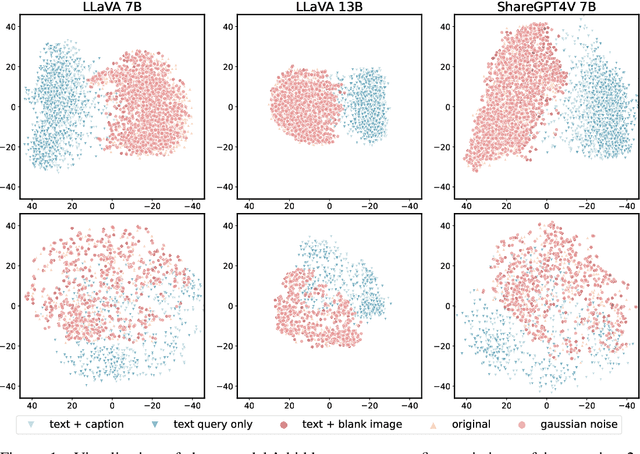
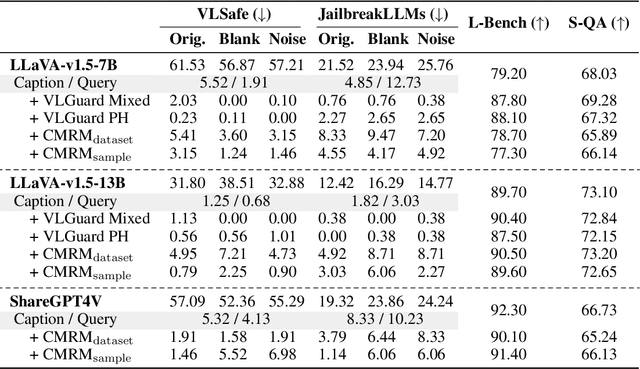
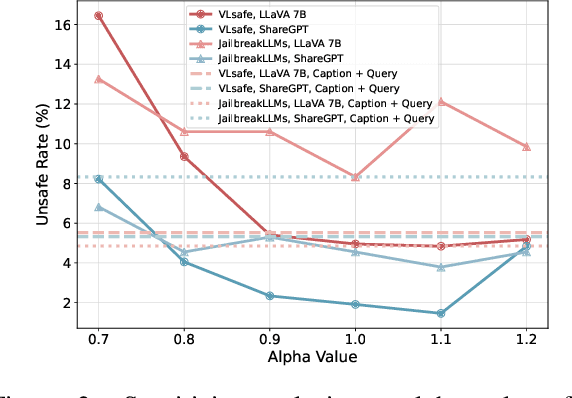

Abstract:The safety alignment ability of Vision-Language Models (VLMs) is prone to be degraded by the integration of the vision module compared to its LLM backbone. We investigate this phenomenon, dubbed as ''safety alignment degradation'' in this paper, and show that the challenge arises from the representation gap that emerges when introducing vision modality to VLMs. In particular, we show that the representations of multi-modal inputs shift away from that of text-only inputs which represent the distribution that the LLM backbone is optimized for. At the same time, the safety alignment capabilities, initially developed within the textual embedding space, do not successfully transfer to this new multi-modal representation space. To reduce safety alignment degradation, we introduce Cross-Modality Representation Manipulation (CMRM), an inference time representation intervention method for recovering the safety alignment ability that is inherent in the LLM backbone of VLMs, while simultaneously preserving the functional capabilities of VLMs. The empirical results show that our framework significantly recovers the alignment ability that is inherited from the LLM backbone with minimal impact on the fluency and linguistic capabilities of pre-trained VLMs even without additional training. Specifically, the unsafe rate of LLaVA-7B on multi-modal input can be reduced from 61.53% to as low as 3.15% with only inference-time intervention. WARNING: This paper contains examples of toxic or harmful language.
 Add to Chrome
Add to Chrome Add to Firefox
Add to Firefox Add to Edge
Add to Edge